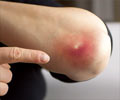
‘A new compound F6 was identified to be as effective as antibiotics approved by FDA to treat life-threatening infections and also proved to be powerful against antibiotic resistant pathogens like MRSA.’
Tweet it Now
"This is very exciting," said Herman Sintim, drug discovery professor in Purdue's Department of Chemistry. "We are not the first to report of a new molecular entity that killed these drug-resistant pathogens. But what is unique about the compound that we found is that when we tried to generate resistance in the lab, we couldn't." The results of the study are published in the European Journal of Medicinal Chemistry.
Antibiotic resistance is a growing public health crisis. The World Health Organization has deemed antibiotic resistance one of the three greatest threats to human health because bacteria are becoming increasingly resistant and too few treatments are being developed. The Centers for Disease Control and Prevention reports that at least 2 million people a year in the United States become infected with bacteria resistant to antibiotics and at least 23,000 people die a year as a result. Studies have estimated that drug-resistant infections could be responsible for 10 million deaths a year worldwide by 2050.
Purdue University researchers have developed a compound called F6 that is 16 times more potent than the closely related F6-15, highlighting the importance of piperidine modification on antibacterial activity.
Pharmaceutical companies have been reluctant to invest in antibiotics because it typically costs millions of dollars to develop a drug and the probability of bacterial resistance is high.
Advertisement
"The idea is that if you keep adding increasing concentrations to bacteria and then you keep regrowing the bacteria, after so many cycles you are going to develop resistance," Sintim said. "Scientists do this to figure out whether whatever they have created develops resistance quickly."
Advertisement
"We are not saying there will never be resistance to the F6 molecule or analogs thereof. What we are saying is that here is a new molecule that works and when we try to force resistance we couldn't generate resistance," Sintim said.
F6, which is nontoxic to humans and other mammals, works against bacteria in a group known as Gram-positive, but not against those that are Gram-negative. F6 was effective against MRSA, VRSA, Enterococcus faecalis, which lives in the human gut, vancomycin-resistant Enterococcus (VRE) and Listeria monocytogenes, often associated with unpasteurized dairy products.
Testing on mice also indicated F6 was as effective as fusidic acid in treating a wound infected with MRSA, further confirming its potent antibacterial effect.
The Purdue researchers will now begin to make derivatives of F6 to see if they might be even more effective. They are working with the Purdue Office of Technology Commercialization to look for partners to help further develop this exciting new molecular entity.
Source-Eurekalert











